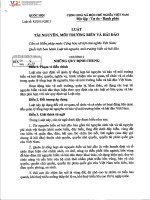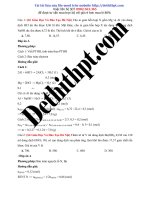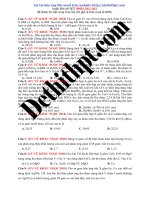Cs224W 2018 82
Bạn đang xem bản rút gọn của tài liệu. Xem và tải ngay bản đầy đủ của tài liệu tại đây (6.01 MB, 12 trang )
Graph-Based Recommendations of Amazon Products
Aaron Effron
Department of Computer Science
Stanford University
Kelly Shen
Department of Computer Science
Stanford University
Stanford, CA 94305
Stanford, CA 94305
Ryan Mui
Department of Computer Science
Stanford University
Stanford, CA 94305
1
Introduction
There is no doubt that recommendation systems have become increasingly relevant
in the modern consumer economy. Two main problems, however, exist in the
construction of such systems: handling sparse user data, as noted by Shams and
Haratizadeh [5], and a need for implicitly derived information, as recognized by
McAuley and Leskovec [3]. To overcome the issue of sparse data, several past
solutions have proposed neighbor-based collaborative filtering methods in which
users and items are represented as a bipartite graph with links between users and
items rated, which is then used to make recommendations.
Others have sought to
extract implicit information from data such as user reviews [3]. Combining the
two strategies, we use the Amazon Product Dataset to construct a graph-based
recommendation system supplemented by implicit information garnered from user
reviews, ratings, and characteristics of their graph structure. The problem we aim to
solve is to recommend an Amazon product that a target user will like, given a user
profile of products bought and the corresponding review metadata of these products.
2
2.1
Related Work
Network-based recommendation algorithms: A review
Yu et al. surveys various network-based recommendation systems and outline differences between them, the impact of these differences, and their performance on three
datasets. The authors further discuss the implications of time on recommendation
systems; the ideal case, reflecting practical use cases, is to predict the most recent
links based on past links rather than removing a random subset of the graph to predict
back. We pursue this direction in our project by splitting our data into train and test
by time, where edges before a certain year are in train, and the test set to predict are
edges after that year.
2.2
Hidden factors and hidden topics: understanding rating dimensions
with review text
McAuley and Leskovec explore a statistical way to use review text content to create
effective recommendation systems. They develop HFT (“Hidden Factors as Topics’’),
a framework using review text to shed light on the underlying hidden structure of
ratings. This framework consists of a latent-factor recommender system used to find
a low-dimensional structure of users and items and a Latent Dirichlet Allocation
(LDA) model which discovers underlying structure in review text. Once the model is
trained, the authors evaluate their methods on various review datasets. As compared
with a simple linear baseline, a latent factor recommender system alone, and an
LDA-based product topic learner alone, HFT achieves the best performance on 30
of 33 datasets in terms of MSE on rating prediction.
2.3.
Finding and evaluating community structure in networks
Newman and Girvan propose a set of community detection algorithms via a topdown approach in which the original graph has edges iteratively removed based on a
“betweenness” measure, recalculated after each removal. This “betweenness” favors
edges between communities over those within communities. One way to measure this
is “shortest-path betweenness”, essentially measuring how many shortest paths run
along each edge; other ways include random walks and circuit theory. To determine
the quality of a given community partitioning, the authors define a ‘modularity
measure’, which measures the fraction of network edges connecting vertices within
a single community, minus the expected value of this quantity in a random network
with random edges but the same community divisions. This comparison to random
ensures strong community structure for higher modularity.
3
Dataset
We use the Amazon Product Dataset [8] aggregated by Julian McAuley of UCSD,
which includes 143 million reviews and corresponding metadata across 20+ domains
between 1996 and 2014. Relevant fields to our recommendation problem include:
1. product information (product id, product type)
2. user/review information (user id, review helpfulness, product rating)
For a given product, we use the helpfulness of and ratings in its reviews to evaluate
its attractiveness. We use the user id to aggregate products a given user has reviewed,
hence creating a profile per user. Among the many domains provided, we use the
Amazon Instant Video and Amazon Office subsets.
4
Network Methodology
We structure our data as a bipartite graph, where users are connected to products
they reviewed (bought) and gave a favorable rating to (> 4).
To create a set of
recommended products for a user, we take the top n products from a ranked set of
refined products, where we experiment with n € {5, 10, 20, 30}. We explore two
approaches to finding a refined product set: community detection (sections 4.1 and
4.2) and leveraging node2vec embeddings (section 4.3),
2
Figure 1: Full bipartite graph of users (left) and products (right) in the Instant Video
domain. The full bipartite graph is similarly dense for several other domains.
4.1
Refined Product Set via Graph Folding and Community Detection
In our first approach to creating a refined product set, we:
1. Create a folded graph
2. Perform community detection and filtering
4.1.1
Folded Graph Creation
To create a folded user graph, we define a threshold 7’ and only connect two users if
they have co-reviewed > TJ’ products, where we experiment with 1 < T’ < 4. We
found that a threshold value higher than 4 loses too much of the information from
the original graph and is incapable of accurate prediction.
We additionally create a graph where edges are weighted by the following Jaccard
similarity metric:
(number of co-reviews)
(size of the union of products both users have reviewed)
As the original graph is fairly dense, we hope that this weighting can distinguish
between closely related pairs of users, and pairs where one or both users review
many products but are not very similar to each other.
4.1.2
Community Detection and Filtering
We perform community detection on the folded user graph to find a cluster of users
most similar to each target user. To do this, we use the Louvain Algorithm [1], as the
algorithm performs well on large graphs, with O(nlogn) run time. Furthermore, it
supports weighted graphs, converges quickly, and produces communities with high
modularity, where modularity is defined as
Q=35,,[4y — $2)5(ci, ¢;)
where A;; is the weight of the edge (7, 7), ki = }); Aij.m = 5 2y Ai, O(U, v) =
(u == v), and c; is the community to which node 7 belongs.
3
As a point of comparison, we also use the Clauset-Newman-Moore community
detection algorithm, as it performs well on large networks and similarly seeks to
maximize modularity [7].
Once we have our clusters, given a user wu, let S' define the set of similar users in the
cluster, and p,, denote the set of all products user wu has bought and given a rating
> 4 (as constrained in the original graph creation). We define the refined set as the
union of p,, across users in S, excluding products already bought by user w.
4.2
Recommending from the Refined Set
To choose a set of items to recommend from this refined set, we do the following:
set
for
recSetSize
(number
of products
to recommend)
each
product
in the
refined
set:
f = number
of times
this
item was
bought
hu = product
hubbiness
(from
original
bipartite
for
each user
review
r of this
product:
extract
product
return
the
score
(h,
=
helpfulness,
p,
=
product
graph)
rating)
= w,*1/fx* >>. (h, *p,) + We *log(f) + w3 * hu
|recSetSize|
items
with
highest
score
The score of a product encodes:
1. Average rating weighted by helpfulness, such that more helpful reviews are
trusted more and higher rated products get a higher score
2. Number of reviews, such that popular products get a higher score («log(f))
3. Product hubbiness, such that products that act more as "hubs" in the original
graph should be rated more highly.
We optimize for the best combination of the above 3 considerations with a set of
weights (w1, w2, w3) as shown in the product score equation. For each graph folding
threshold and recommendation set size, we do a grid sweep over the following range:
0
0 < w3 < 500, step size 50 (0, 50, 100, ..., 450)
The weights for w3 are an order of magnitude higher because we observe that
hubbiness scores tend to be an order of magnitude smaller than the other two terms,
and we want to allow all three terms to contribute proportionally.
Our scoring function as defined above is community-agnostic in its rating scheme.
To encode community information, we also explore "community-specific" recommendations, where a product’s score is calculated based only on reviews from the
users in the community who bought the product. We find that "community-specific"
recommendations consistently outperform the general case, and thus all reported
results are using community-specific recommendations.
4.3
node2vec
We explore two additional node2vec approaches that run parallel to the two-step
procedure defined in 4.1 and 4.2. The first uses node2vec embeddings as a proxy for
4
user profiles, from which a community of users is created per target user based on
the similarity of their embeddings. This replaces the community detection method
in 4.1, and continues downstream to use the refined set scoring described in 4.2.
The second approach uses node2vec embeddings as a proxy for product profiles,
and directly uses similarities to embeddings of a target user’s past purchases to
recommend potential products. In both approaches, node2vec is run on the original
bipartite graph using 100 random walks, a p value of 1, and a q value of 2. We select
q > p to characterize a microscopic view of the graph, where nodes with similar
network roles have more similar embeddings.
4.3.1
node2vec User Similarity
In this approach, the user node2vec embeddings are aggregated into a matrix, row
normalized, and the user-pair cosine similarity scores are computed. The similarity
scores per user u (each row of the similarity matrix) are then ordered from highest
to lowest, and the top 20 most similar users are selected to be u’s community.
From here, community-specific product scoring as defined in 4.2 is executed with
the optimal weight combination found through grid search. Note that though we
construct a community for user u, we look for structural similarity in our random
walks because we want u to be compared to nodes that share similar roles in the
original graph, as opposed to those which are simply proximal (proximity makes
more sense in the folded graph).
4.3.2
node2vec Product Similarity
In this approach, the product node2vec embeddings are aggregated into a matrix, row
normalized, and the product-pair cosine similarity scores are computed. For each
user u, the set of products p,, that u has reviewed (bought) previously is collected.
For each product in p,,, we find the top 10 most similar products, and aggregate this
across all products in py INtO Py. meng? ONCE Purecommena 18 constructed, similarity
scores for each element Of Đụ
a2 8fe updated to be the sum of similarities to
each product in p,, (as opposed to simply a similarity to a single product). Pu... end
(excluding products already in p,,) is then ordered by these updated similarity scores,
and the highest |recSize| products are returned as the recommendation set for
u. Unlike all previously discussed methods, this pipeline directly recommends
products using product similarity, rather than first finding similar users and then
recommending products associated with those respective user profiles.
5
Evaluation
To evaluate our recommendations, we:
1. Split edges from the original graph into 80% train/ 10% val/ 10% test
2. Create product recommendations based on information from the train graph.
To choose optimal score weights, we perform a grid sweep as described in
4.2, and select the weights that produce the best recommendations on the
validation set of edges for the Instant Video graph. All prediction methods
uses these weight values.
3. Perform predictions on the test set of edges.
5
We evaluate on a test set of edges generated through random splitting, as well as
temporally based splitting (predict future purchases based on past behavior).
5.1
Metrics of Evaluation
Let {s,,} = the recommended products list for user u, per user
and test = the set of user-item edges we would like to predict.
We define the following metrics:
1. Recall:
,
| test edges (u, p) for which p appears in s,,|
2. Precision:
3.
Fl
Test
20 * | test edges (u, p) for which p appears in s„,|
|num users in test set * rec set size|
. 2 * Precision * Recall
Score:
Precision + Recall
Recall measures how often true test user-item relations are discovered by our algorithm, and high recall means that we recover most of the test edges.
Precision measures how many guesses we require to discover true user-item edges,
in that a smaller recommendation set with the same number of test edges discovered
as a larger recommendation set will get a better precision score. High precision
means that our recommendations have high concentration of test edges.
We multiply by 20 in the numerator of precision for multiple reasons:
e This multiplicative factor makes precision and recall the same order of
magnitude, allowing a proper F1-score.
e Ina test set of all unique users, a recommendation set size of 20 per user that
accurately predicted every edge would get a precision of 1 (precision should
technically be the min of our expression and 1, but this issue never pops up
in our analysis).
Note that we have removed average ranking score since our milestone, because
we realized that this metric measures relative preference among reviewed products,
which is not encoded in the data we are working with.
5.2
Baselines
To evaluate the significance and efficacy of our results, we compare to the following
baselines:
1. Truly Random:
mend.
For each user, choose a random set of products to recom-
2. Score Random: For each user, choose a random set of products from that
user’s community, ignoring the score.
3. Global: For each user, choose based on the globally most popular products,
ignoring community structure.
The truly random baseline measures whether our algorithm generally is able to make
recommendations, the score random baseline measures if our scoring algorithm
works well, and the global baseline measures if our community structure is important.
6
Table 1: Optimal weights as found by grid search
Rec Size
Weights1
Weights2
Weights3
Weights4
Weights Weighted
5
10
(1,4, 100)
(3, 7,200)
(1, 6, 0)
(1, 9, 200)
(1,7,100)
(1, 4, 0)
(1,7,100)
(1, 4, 0)
(1,7, 150)
(1, 4, 150)
20
30
(1,7, 200)
(1,4, 350)
(3,5,200)
(1, 10,300)
(1,7,400)
(1,7,350)
(1,7,400)
(1,7,350)
(2,7, 400)
(1, 7, 250)
6
Results
We present our optimization results in Table 1, and recommendation results in Tables
2 and 3.
6.1
Optimization Results
To populate our recommendation results tables, we optimized parameters for all fold
values of the instant video graphs, and then fixed these parameters when evaluating
on the office products graph and the temporally separated version of the instant video
graph.
We observe that a larger recommendation set size tends to correlate with a larger
weight placed on the hubbiness of the product in the original graph. This may
indicate that hubbiness is only good differentiator among recommendations further
down a list.
6.2
Analysis
In tables 1 and 2, we observe that we are able to outperform every baseline across
all datasets, meaning our parameter optimization produces meaningful performance
and also is able to generalize. Due to the poor performance of node2vec methods
relative to the community detection + scoring from refined set methods, node2vec
results are not included.
We observe in table 2 that a higher folding threshold leads to a larger outperformance of the global baseline. One possible reason for this is that higher threshold
values produce more and smaller communities, allowing community structure to
differentiate scoring from a global score list. In addition, we observe that a lower
folding threshold leads to a larger improvement over the score random baseline.
Lower threshold values have few and large communities, such that score becomes
the important differentiating factor.
We additionally measure the effect of recommendation set size on performance.
Though recall will always improve with a larger recommendation set size, we see
that this will not always be the case for Fl-score: for example, Folded 1 achieves
a higher Fl-score for rec set size of 20 than 30, indicating that the precision drop
outweighs the recall gain. However, we also see that Folded3 and Folded4 have
very low F1 scores, likely because their low recall values singlehandedly drag down
the Fl-scores. Future optimization could involve examining if different weightings
between precision and recall highlight different characteristics of the folding methods
(e.g. the ability of high fold values to outperform the global random baseline).
7
Table 2: Recommendation algorithm performance on instant video graphs. Improvements are % improvements over the relevant baselines (Glob = Global, TR
= True Random,
SR = Score Random).
recommendation set size are bolded.
Graph Type
Weighted
Folded 1
Folded2
Folded3
Folded4
The best values for each metric for each
Rec Size
Fl
Recall
ImpoverGlob
Impover TR
Imp over SR
5
10
20
30
5
10
20
30
5
10
20
30
5
10
20
30
5
10
20
30
0.1684
0.1951
0.21
0.2106
0.1574
0.1807
0.2088
0.2032
0.1592
0.1832
0.2049
0.2142
0.0684
0.0834
0.0984
0.099
0.0149
0.0204
0.0203
0.0212
0.0999
0.134
0.1834
0.2233
0.0934
0.1241
0.1824
0.2155
0.0944
0.1258
0.179
0.2271
0.0406
0.0573
0.0859
0.105
0.0089
0.014
0.0177
0.0225
90.29
50.06
15.93
12.72
75.57
38.19
14.63
12.15
123.17
71.62
33.28
34.86
101.99
54.03
38.33
35.66
229.63
154.55
33.08
17.8
3600
1761.11
1960.67
1419.05
2339.47
2027.59
2220.51
976.1
3833.33
2187.27
1588.68
1522.14
2800
5630
1852.27
2286.36
2866.67
1900
1164.29
1223.53
1858.82
1085.84
896.74
786.11
1498.28
849.23
964.71
738.78
1211.11
957.14
732.56
474.94
524.62
249.39
219.33
210.65
74.51
70.73
52.59
37.2
Though our recall values generally are quite low (never exceeding .22), we are
successfully able to outperform baselines in all areas, and generalize beyond the data
trained on. Therefore, while our system may not work as a recommendation system
on its own, it clearly is able to deduce meaningful connections between users and
the products they enjoy.
7
Community Visualization
In order to better understand our graphs, we constructed visualizations using networkx show below in Figure 2. Nodes represent communities, and edges the
existence of co-reviewed products between communities. The size of a node is
proportional to the number of nodes in a community, and the width of an edge is
proportional to the number of edges between two communities. This graph visualization method was chosen because it is infeasible to clearly depict all nodes and
edges.
From these depictions, we can gain insight into the structure of our graphs, and
consequently intuition as to how well our prediction algorithms perform. We observe
that the Folded1 graph with Louvain communities is fully connected, as a low
threshold allows for more connections both within and between communities. In
comparison, higher threshold graphs display fragmentation, with larger central nodes
and many small isolated satellite nodes. The central communities likely represent
8
Figure 2: Community visualizations from the Instant Video data. Rows 1-4 depict
fold1/2/3/4, the left/right column show Louvain/CNM detection, and Row 5 displays
weighted Lovain.
Table 3: Recommendation algorithm performance on temporally separated instant
video (TIV) and office products (OP). We dispplay only rec size of 10 and 30 to
demonstrate generalization without cluttering.
Graph Type
Rec Size
Recall
Imp. over Global
Imp over SR
OP Weighted
10
30
10
30
10
30
10
30
10
30
10
30
0.0545
0.124
0.0527
0.105
0.0501
0.1156
0.013
0.0365
0.0123
0.0338
0.0048
0.0232
32.28
26.4
29.17
7.91
31.15
20.79
550
38.78
156.25
28.52
9.09
6.42
701.47
588.89
602.67
427.64
922.45
564.37
154.9
88.14
123.64
148.53
140
118.87
OP Folded1
OP Folded2
TIV Weighted
TIV Folded!
TIV Folded2
groups of users who review many popular products. some central communities have
extremely high connectivity as evident by the thick edges. Satellite nodes can best
be thought of as users who only reviewed the same niche products.
Supporting our visual observations, in table 4 we observe that the 1-folded and
weighted graphs have large communities (>200 users, >450 products); in comparison, 2/3/4 folded graphs have many 2-user communities, and include some
communities with large number of products as in 1/weighted, but also communities
with a more desirable number of products (10-100). Additionally, modularity appears positively correlated with fold threshold, but independent from the number of
communities.
Table 4: Community Structure for instant video and office product graphs. Q is the
community modularity; ICI is the number of communities; U Extrema (P Extrema)
are the minimum and maximum number of users (products) per community across
all communities; CC is clustering coefficient.
Graph
Fold
Nodes | Edges |
inst_vid | |
5054 | 609822 |
2
4124 | 56885 |
3
1709 | 5984
4
426
643
weighted | 5054 | 609822 |
off_prod | 1
4878 | 601018 |
2
3703 | 81357 |
3
1829 | 17704 |
4
876
5231
weighted | 4878 | 601018 |
10
Q
.382 |
.608 |
721 |
8
.399 |
.208 |
.238 |
.289 |
.357 |
.214)
ICl |
7 |
31 |
88 |
56 |
8 |
5 |
66 |
46 |
20 |
5 |
U Extrema |
[193, 1631] |
[2, 819]
[2, 254]
[2, 60]
[256, 1866] |
[224, 2025] |
[2, 763]
[2, 394]
[2, 186]
[89, 2048] |
PExtrema |
[456, 1370] |
[3, 911]
[4, 493]
[5, 394]
[454, 1431] |
[850, 2078] |
[4, 1468]
[6, 1247]
[7, 967]
[430, 2072] |
CC
.503
492
343
.218
.503
.411
417
408
420
.411
8
Future Work
There are multiple future directions that this work could take:
1. As user-product recommendations are a form of link prediction, we could
use a stochastic block model (SBM) to predict the emergence of links given
an initial graph. This would particularly be applicable in the temporal case,
as the SBM could use the current state to predict the future graph state.
2. The current bipartite graph is dense; additional techniques beyond the current
thresholding/weighting to eliminate less meaningful edges could involve
network deconvolution, by which we separate direct and indirect connections.
3. Similarity metrics could incorporate review text. We implemented a preliminary version, in which a similarity score between two users was calculating
by finding the max/avg cosine distance between all pairs of respective user
reviews with stop words removed. This method only slightly improved
performance, and more complex methodologies could be explored.
11
References
[1] Blondel, Vincent D., et al. "Fast unfolding of communities in large networks." Journal
of statistical mechanics: theory and experiment 2008.10 (2008): P10008.
[2] Kannan, Ravi, Santosh Vempala, and Adrian Vetta.
"On clusterings:
spectral." Journal of the ACM (JACM) 51.3 (2004): 497-515.
[3] McAuley, Julian, and Jure Leskovec.
Good, bad and
"Hidden factors and hidden topics: understanding
rating dimensions with review text." Proceedings of the 7th ACM conference on Recommender systems. ACM, 2013.
[4] Newman, Mark EJ, and Michelle Girvan. "Finding and evaluating community structure
in networks." Physical review E 69.2 (2004): 026113.
[5] Shams, Bita, and Saman Haratizadeh. "Graph-based collaborative ranking." Expert
Systems with Applications 67 (2017): 59-70.
[6] Yu, Fei, et al. "Network-based recommendation algorithms:
Statistical Mechanics and its Applications452 (2016): 192-208.
A review." Physica A:
[7] Clauset, Aaron, Mark EJ Newman, and Cristopher Moore. "Finding community structure
in very large networks." Physical review E 70.6 (2004): 066111.
[8] McAuley, Julian. 2014. Amazon Product Data: />
12









